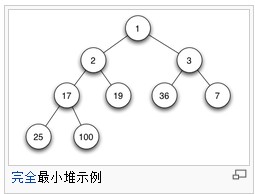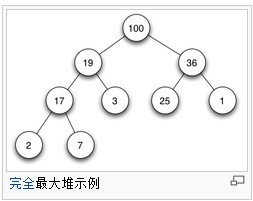定义:
最大堆:根结点的键值是所有堆结点键值中最大者的堆。
最小堆:根结点的键值是所有堆结点键值中最小者的堆。
C++中的STL里边定义的堆操作:
STL里面的堆操作一般用到的只有4个:make_heap();、pop_heap();、push_heap();、sort_heap();
他们的头文件函数是#include <algorithm>
首先是make_heap();
他的函数原型是:void make_heap(first_pointer,end_pointer,compare_function);
一个参数是数组或向量的头指针,第二个向量是尾指针。第三个参数是比较函数的名字。在缺省的时候,默认是大跟堆。(下面的参数都一样就不解释了)
作用:把这一段的数组或向量做成一个堆的结构。范围是(first,last)
然后是pop_heap();
它的函数原型是:void pop_heap(first_pointer,end_pointer,compare_function);
作用:pop_heap()不是真的把最大(最小)的元素从堆中弹出来。而是重新排序堆。它
把first和last交换,然后将[first,last-1)的数据再做成一个堆。
接着是push_heap() void pushheap(first_pointer,end_pointer,compare_function);
作用:push_heap()假设由[first,last-1)是一个有效的堆,然后,再把堆中的新元素加
进来,做成一个堆。
最后是sort_heap()void sort_heap(first_pointer,end_pointer,compare_function);
作用是sort_heap对[first,last)中的序列进行排序。它假设这个序列是有效堆。(当然
,经过排序之后就不是一个有效堆了)
转载:http://blog.csdn.net/hnust_xiehonghao/article/details/9172875
用最大堆做一道ACM题目:POJ 2442:
POJ 2442 http://poj.org/problem?id=2442
| Time Limit: 6000MS | Memory Limit: 65536K | |
| Total Submissions: 5910 | Accepted: 1813 |
Description
Input
Output
Sample Input
1 2 3 1 2 3 2 2 3
Sample Output
3 3 4
Source
给你n*m的矩阵,然后每行取一个元素,组成一个包含n个元素的序列,一共有n^m种序列,
让你求出序列和最小的前n个序列的序列和。
思路 :来自下面的博客
http://www.cnblogs.com/vip-wy/archive/2012/02/15/2353064.html
解题步骤:
1.将第一序列读入data1向量中,并按升序排序。
2.将数据读入data2向量中,并按升序排序。
将data2[0] + data1[i] ( 0<=i<=n-1)读入dataq向量中
用make_heap对dataq建堆。
然后data2[1] + data1[i] (0<=i<=n-1),如果data2[1] + data1[i]比堆dataq的顶点大,则退出,否则删除
堆的顶点,插入data2[1] + data1[i]。然后是data2[2],...data2[n - 1]
3.将dataq的数据拷贝到data1中,并对data1按升序排序
4.循环2,3步,直到所有数据读入完毕。
5.打印data1中的数据即为结果。
代码:#include<algorithm>
#include<iostream>
using namespace std;
bool cmp(int a,int b)
{
return a>b;
}
int main()
{
int Case = 0 , i , j , k;
int n = 0 , m = 0;
int data1[2001],data2[2001],sum[2001];
cin >> Case;
while(Case--)
{
cin >> m >> n;
for(j = 0 ; j < n ; j ++)
{
cin >> data1[j];
}
for(i = 1 ; i < m ; i ++)
{
sort(data1,data1+n);
for(j = 0 ; j < n ; j ++)
{
cin >> data2[j];
}
sort(data2,data2+n);
for(j = 0 ; j < n ; j ++)
{
sum[j] = data1[0]+data2[j];
}
make_heap(sum,sum+n);
int temp = 0;
for(k = 1 ; k < n ; k ++)
{
for(j = 0 ; j < n ; j ++)
{
temp = data1[k]+data2[j];
if(temp > sum[0])
{
break;
}
else
{
pop_heap(sum,sum+n);
sum[n-1] = temp;
push_heap(sum,sum+n);
}
}
}
for(j = 0 ; j < n ; j ++)
{
data1[j] = sum[j];
}
}
sort(data1,data1+n);
for(j=0;j<n-1;j++)
printf("%d ",data1[j]);
printf("%d\n",data1[j]);
}
return 0;
}对于堆的优化,可以使用优先队列,见这片文章
priority_queue详细的用法,见这里

























 6037
6037











 被折叠的 条评论
为什么被折叠?
被折叠的 条评论
为什么被折叠?








